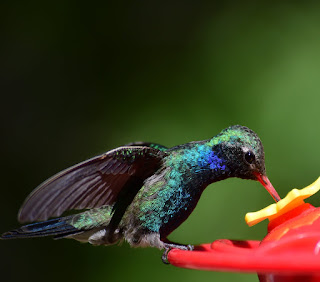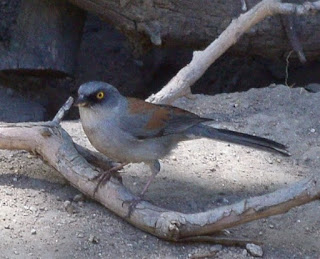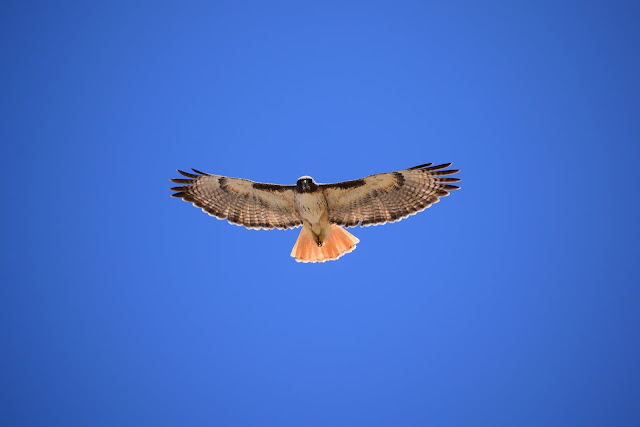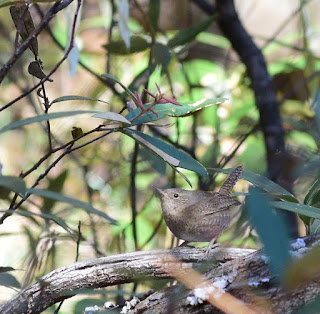Madera Canyon is popular with birders, hikers, campers and picnickers.
It's only 40 easy miles from the Tucson airport, and it's in the Santa Rita Mountains, one of the most biologically rich parts of the whole country.Birders come from around the world! There are four places to stay in the canyon. Three (Santa Rita Lodge, Madera Kubo, and Chuparosa Inn) cater to birders, with lots of well-stocked feeders and knowledgeable staff. We stayed at the Lodge (Maeve's sixth visit!), which provides basic motel-type rooms and a few simple cabins.




The Lodge has a large feeder area with benches and chairs for birders. The birds are so accustomed to being watched that they rarely take notice of the hordes of people with binoculars, spotting scopes and cameras.
Below: Broad-billed Hummingbird, Acorn Woodpecker, Pine Siskins and Lesser Goldfinches, Hepatic Tanagers, Yellow-eyed Juncos.

















Rivoli's Hummingbirds are much larger than all the other regulars in this area. Their old name, Magnificent Hummingbird, was very appropriate!

Black-chinned Hummingbirds usually look, well, black-chinned. But occasionally the males flash their gorgeous purple gorgets.


Bow tie or ribbon or gorget - either way, stylish and delightful.

Throughout our three week tour of Arizona's sky islands, we noticed that Broad-billed Hummingbirds seem more willing to pose for pictures than any other species.



Note the pollen just above the beak.


Acorn Woodpeckers are the clowns of the avian world. They're communal birds, usually coming to feeders in large noise groups.



The song of the Black-headed Grosbeaks sounds a bit like an American Robin's but even sweeter.

Arizona Woodpecker


Mexican Jays are another loud flocking species.





More hummingbirds - because that's what Arizona's "sky islands" are all about!







Maeve's first visit to Madera Canyon was a hiking trip with daughter Megan, who was astonished when she saw these birds for the first time. "They look demented!"






There are two picnic areas, one at the bottom of Madera Canyon and one about a third of the way up. They can both be crowded on weekends but usually not during the week.




Black-throated Gray Warbler
Both picnic areas have trails that cry out to be walked and enjoyed.



On one memorable walk, we stopped and watched this little female on her nest. We originally identified her as an Anna's, but when we got home and studied the photo the dark smudge (shadow?) under the eye, and the absence of streaks on the throat, dissuaded us. Now we're not sure what she is!










The Nature Trail, heading uphill from the lodging area, is a beautiful hike. Along with dramatic views, warblers and flycatchers, birders might catch sight of an elusive Montezuma Quail. (We heard them but didn't get a photo on this trip.)
We waited a minute
then sauntered for hours.



from Proctor Picnic Area











Madera Creek parallels the road from the canyon's top to bottom. We were surprised and pleased to see this much water since the area is in a multiyear drought.







Nine thousand foot Mt. Wrightson can have snow as late as June. The hike to the top has a lot of switchbacks, so it's easier than most of our Vermont mountain trails.

Bernie spent almost an hour with this little House Wren, on one of the trails starting at the very end of the road.



House Wrens in southeastern Arizona are sometimes called "Brown-throated House Wrens". They're the same species as our eastern birds but they're generally lighter in color than the northern birds and have warm brown and tan plumage.
Below: The Cornell Lab of Ornithology describes Steller's Jays as hefty, crested birds with attitude.



 |
| Hermit Thrush - Vermont's state bird! |



















This sly Hummer was playing peek-a-boo with us.













Wild Turkeys come to the Santa Rita Lodge feeders. Occasionally one will jump/fly up to a feeder and balance precariously while gobbling some seed.













We kept hearing this loud sound we did not recognize. The sound seem to echo from far away yet we could hear it while in many of the places we hiked. Finally while Bernie was doing a solo hike, the sound seemed closer. Upon venturing toward a stream the sound grew much louder, yet Bernie continued to look in the trees thinking it was a bird making the sound. At the edge of the stream the sound erupted very loudly. Bernie looked down and watched as a small frog, or toad gulped and gulped air blowing itself to nearly twice its original size then releasing a belch that would make any (male) beer drinker proud. Such a small animal for a long carrying bull horn of a sound. Hats off to you little fellow-I hope you win her heart.
















A very grand description of a very grand place. Santa Rita Lodge should be considered a Mecca for everyone who considers him/herself a birder. My significant other isn't a birder, but she would love to just sit on the bench and watch the feeders!
ReplyDeleteamazing photos from an amazing place
ReplyDelete